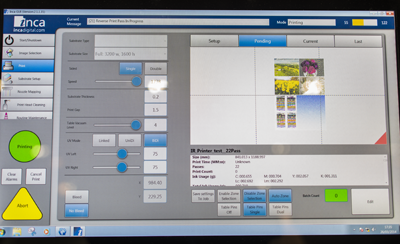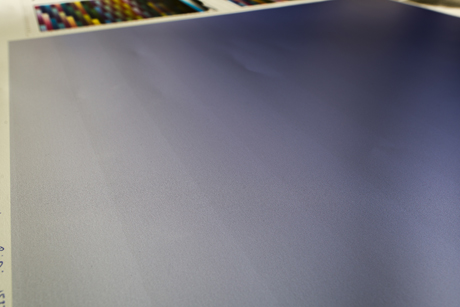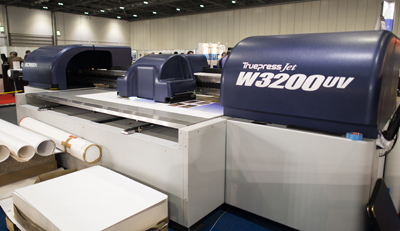The prototype shown at Fespa 2013 was impressive, so Nessan Cleary went to see if it’s living up to its promise.
Last year at Fespa 2013 in London both Screen and Fujifilm showed a version of a new mid-range flatbed printer that had been developed by Cambridge-based Inca Digital. Screen, which owns Inca Digital, subsequently launched the machine at the end of last year as the Truepress Jet W3200UV. So far two of these have been installed in the UK, and the machine that we tested - at Ipex - was due to be installed at a Dutch printer shortly afterwards. Martijn van den Broek, sales manager for Screen’s wide-format products, says that the company is still in the process of setting up a distribution network for the rest of Europe.
There are several configurations available, though the machine we tested had the full set of CMYK plus light cyan and light magenta as well as two white channels. But it could be set up for CMYK or as a six colour machine with a choice between the light colours and the white ink, and any of these configurations can be changed during the life of the machine. The white inks can be used as a spot colour without affecting the speed of the machine, but printing a white layer will slow the printer down.
It’s a large machine, capable of taking either rigid or flexible media up to 3.2 x 1.6m and 50mm thick. The printheads are mounted on a gantry that moves left to right, while the bed moves underneath the heads. The bed, which is divided into eight zones, moves on linear motors and Screen claims that there is no vibration.
The unit uses Fujifilm Dimatix printheads, with 600dpi, though Screen claims an apparent resolution of 1000dpi. These yield a fixed drop size of 14 picolitres, which sounds on the large size and yet the printer is capable of reproducing exceptionally fine detail. The heads are kept at a constant 45 degrees through liquid cooling in a closed system. Van den Broek says: “It keeps the ink viscosity equal under all conditions so the ink always behaves the same.”
 Van den Broek stresses the need for preventative maintenance to keep any inkjet system running, which is good advice since the major cause of head failures is blocked nozzles.
Van den Broek stresses the need for preventative maintenance to keep any inkjet system running, which is good advice since the major cause of head failures is blocked nozzles.
There are two types of cleaning. This includes a wet clean, which involves spraying a flushing solution over the heads and is normally done every eight hours at a shift change. This is an automated process but takes 10-12 minutes. There's also a dry cleaning process, which mainly uses airflow to blow away dust and is usually done in the morning when the machine is started up. This also takes about 10 minutes and also includes printing a test chart to ensure that everything is working. The printer itself is never actually turned off.
There's considerable scope for nozzle mapping because there is some redundancy with not all nozzles used for all passes. In addition, there are two vents with filters in the heads that create an airflow, which prevents an image mist from settling on the heads andhelps to keep the nozzles from blocking. The filters should be changed daily.
The ink comes from Fujifilm's Speciality Ink Systems though van den Broek stresses that this ink has been specifically developed by Screen. The W3200 uses the same ink as Screen’s older Truepress Jet 2500, which was a hybrid UV printer so the inks are high density for good colour and very flexible, stretching up to 200 percent.
The demo model that we used was configured with a Caldera Rip though Screen also supports Colorgate, Wasatch and Onyx. Unlike the ColorPainter that we tested last month, there's no option to run the printer from the Rip. Instead the Ripping is kept separate from the printer, which perhaps makes most sense in the high production environments that this machine is designed for.
Instead the W3200 is run from a separate workstation on the front right hand corner. This has a large touchscreen so it’s easy to see what's happening with the machine and to make changes. From here the operator can run all the machine functions, including maintenance and job settings. Once the jobs are Ripped they are sent to the job queue on the control station. Jobs can be archived here and previous jobs searched for in the case of reprints or simply deleted.
The operator has a considerable amount of control over the job settings, such as the number of passes, whether or not to print bi-directionally, the power of the curing lamps and the gap between the heads and the substrate.
The workstation also reports the basic statistics of each job such as the running time and the amount of ink used. It can predict the ink usage based on the Ripped data. The workstation also includes a remote diagnostic system so that Screen's engineers can examine how the machine is set up if there's a problem.
On test
For these tests we use two A0-sized charts, one having mainly solid Pantones, plus some images and resolution tests, and the other having mainly images including a large reflex blue gradient.
We printed both charts at the highest quality mode of 22 passes to check the image quality and at 14 passes, which makes the most sense as a general production setting. The charts were printed in portrait mode to put them side by side on a sheet, but of course they would have printed slightly quicker had we turned them to landscape mode. Nonetheless, both charts took 2.56 minutes at 22 passes and 2.06 minutes at 14 passes.
 It takes roughly five minutes for the lamps to warm up from cold, and they (and the vacuum bed) will automatically turn off after ten minutes if the machine is not used.
It takes roughly five minutes for the lamps to warm up from cold, and they (and the vacuum bed) will automatically turn off after ten minutes if the machine is not used.
Strangely, the 14-pass mode seemed to use slightly more ink, taking 11.07 ml for the Pantone chart, and 9.88 for the image chart, as against 10.88ml and 9.71ml respectively for the 22-pass mode.
There was very little difference in terms of image quality between the 14-pass and 22-pass images. The text panel on the 14-pass sheet was easily legible down to 3pt, and even the 2pt text could just about be read. Although the 22-pass chart was similar, there was some improvement, with some of the images being brighter.
We did see some noticeable banding on the graduated blue panel on the 14-pass image, though as soon as you step back a foot or so this disappears. There’s no banding on any of the solid Pantone panels or any other image at 14 pass, and none at all on the 22 pass image.
Conclusion
The W3200UV costs £250,000 for the full configuration as tested here. There's a service contract which costs £1,000 a month and doesn't include the cost of replacement heads. The heads cost around £2,000 each and are not user replaceable, which means calling out a service engineer to replace them, though Screen says that the maintenance programme should ensure they last for a long time. The lamps should last for 500 hours, which is fairly standard for most UV-curable printers. It takes about a week and a half to install the machine and train an operator.
Van den Broek wouldn’t be drawn on the ink price, saying that Screen is considering reducing the price. Unfortunately, it’s impossible to draw any conclusions as to whether or not this printer represents good value without knowing the cost of the inks. That said, the print quality is extremely good, and the machine appears to be a solid workhorse capable of 24/7 production.
{jathumbnail off}


